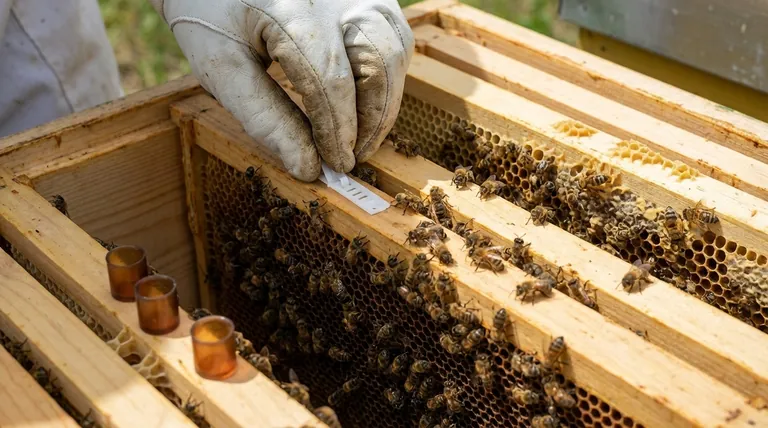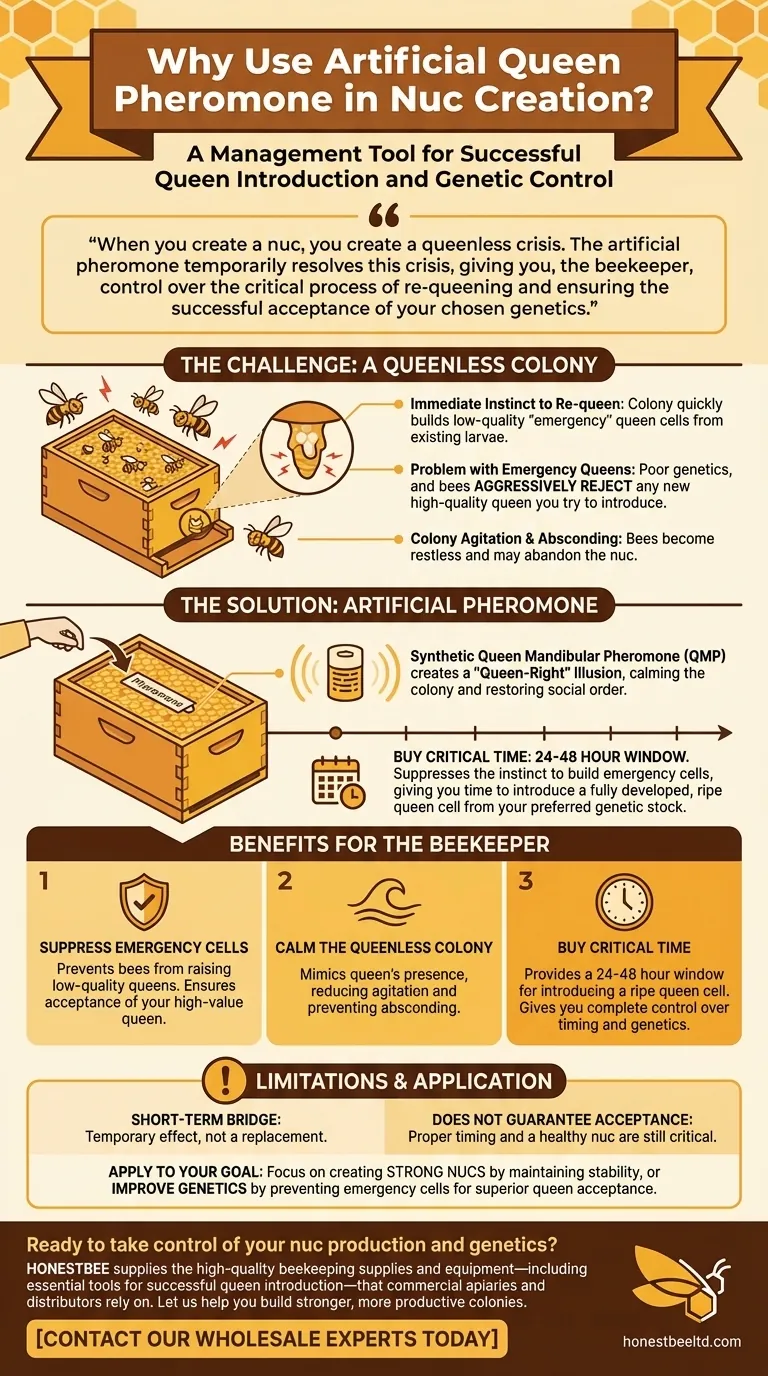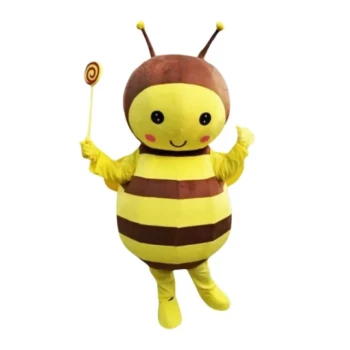In short, an artificial queen pheromone is a management tool used to trick a newly created nucleus colony (nuc) into thinking it has a queen. This temporary deception keeps the bees calm and, most importantly, prevents them from creating their own low-quality "emergency" queen cells, which would cause them to reject the high-quality queen you intend to introduce.
When you create a nuc, you create a queenless crisis. The artificial pheromone temporarily resolves this crisis, giving you, the beekeeper, control over the critical process of re-queening and ensuring the successful acceptance of your chosen genetics.

The Challenge of a Queenless Colony
To understand the pheromone's role, you must first understand the immediate and powerful instinct of a honey bee colony when it loses its queen.
The Immediate Instinct to Re-queen
A colony's survival depends entirely on its queen. Within hours of becoming queenless, the worker bees' behavior changes dramatically. Their primary biological directive is to create a new queen immediately.
They do this by selecting several very young female larvae (less than three days old) and feeding them a special diet of royal jelly. This triggers the development of a new queen in what is called an emergency queen cell.
The Problem with Emergency Queens
While this natural process can save a colony, it presents a major problem for the beekeeper creating a nuc.
First, an emergency queen's genetics are from the original colony, which may not be the desirable, selected genetics you want to propagate. Second, and more critically, once the bees have started their own queen cells, they consider the problem solved. They will aggressively reject and kill any new queen or ripe queen cell you try to introduce.
Colony Agitation and Absconding
Without the presence of queen pheromone, a colony's social cohesion begins to break down. The bees become agitated, restless, and are more likely to abscond, meaning the entire colony abandons the nuc box.
How Artificial Pheromone Solves the Problem
The artificial pheromone is a synthetic copy of the Queen Mandibular Pheromone (QMP), the primary chemical signal a queen uses to communicate her presence.
Creating a "Queen-Right" Illusion
By placing the artificial pheromone lure in the nuc, you distribute this familiar "I am here" signal throughout the small colony. The worker bees detect it and behave as if a healthy, laying queen is present.
This immediately calms the cluster, restores social order, and encourages normal foraging and brood care behavior.
Buying Critical Time for the Beekeeper
Most importantly, the pheromone suppresses the bees' instinct to build emergency queen cells. This gives you a crucial window of opportunity, typically 24 to 48 hours, to introduce a fully developed, "ripe" queen cell from your preferred genetic stock.
Because the bees believe they are queen-right, they do not start the emergency process. By the time the pheromone's influence wanes, your introduced queen is ready to hatch and will be accepted as their natural successor.
Understanding the Limitations
While effective, this tool is not a magic bullet. It has a specific and temporary purpose.
It Is a Short-Term Bridge
The artificial pheromone is a placeholder, not a replacement. Its effect is temporary. It is designed to bridge the short gap between making the nuc queenless and introducing the new, nearly-hatched queen cell.
It Does Not Guarantee Acceptance
Proper timing is still critical. If you wait too long to introduce your new queen cell, the pheromone's effect will wear off, and the bees may begin building emergency cells anyway. Successful introduction still depends on having a healthy, well-fed nuc and a viable queen cell.
How to Apply This to Your Goal
Use this knowledge to ensure your queen rearing and nuc creation efforts are successful.
- If your primary focus is creating strong nucs: Use the pheromone to maintain colony stability and prevent bees from absconding while you wait to introduce your chosen queen cell.
- If your primary focus is improving genetics: Use the pheromone to prevent the colony from raising its own emergency queen, which ensures they accept the genetically superior queen you are providing.
Ultimately, the artificial queen pheromone is a strategic tool that gives you control over a colony's powerful natural instincts.
Summary Table:
| Purpose | Key Benefit | Outcome for Beekeeper |
|---|---|---|
| Suppress Emergency Queen Cells | Prevents bees from raising their own, low-quality queen. | Ensures acceptance of your chosen, high-genetic-value queen. |
| Calm the Queenless Colony | Mimics a queen's presence, reducing agitation and preventing absconding. | Maintains a stable, productive nuc during the critical introduction period. |
| Buy Critical Time | Provides a 24-48 hour window for introducing a ripe queen cell. | Gives you complete control over the timing and genetics of requeening. |
Ready to take control of your nuc production and genetics?
HONESTBEE supplies the high-quality beekeeping supplies and equipment—including essential tools for successful queen introduction—that commercial apiaries and distributors rely on. Let us help you build stronger, more productive colonies.
Contact our wholesale experts today to discuss your needs and elevate your beekeeping operation.
Visual Guide

Related Products
- Brown Nicot Queen Cell Cups for Breeding Queen Bees Beekeeping
- Professional Galvanized Hive Strap with Secure Locking Buckle for Beekeeping
- HONESTBEE Professional Hive Top Bee Feeder Feeding Solution
- Boardman Entrance Bee Feeder Durable Galvanized Steel and Wood Construction for Beekeeping
- Plush Bee Mascot Costume Professional Engaging Brand Ambassador
People Also Ask
- How many cells are given to a nucleus? Understand the One-to-One Rule in Cell Biology
- What is the advantage of the Nicot Cupkit system? Secure Your Queen Rearing Success with Batch Protection
- How are the queen cells raised after removing the plugs? Master the Art of Queen Rearing
- What is the benefit of inducing supersedure by giving a queenright colony a protected queen cell? A Seamless Requeening Method
- What role does the natural swarming process play in queen rearing? Harness the Swarm Instinct for Better Queens



















